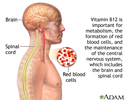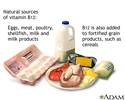Vitamin B12
Cobalamin; Cyanocobalamin
Vitamin B12 is a water-soluble vitamin. Water-soluble vitamins dissolve in water. After the body uses these vitamins, leftover amounts leave the body through the urine.
The body can store vitamin B12 for years in the liver.
Function
Vitamin B12, like the other B vitamins, is important for protein metabolism. It helps in the formation of red blood cells and in the maintenance of the central nervous system.
Food Sources
Vitamin B12 is naturally found in animal foods such as fish, meat, poultry, eggs, milk, and milk products. Vitamin B12 is generally not present in plant foods. Fortified breakfast cereals are a readily available source of vitamin B12. The vitamin is more available to the body from these cereals for vegetarians. Some nutritional yeast products also contain vitamin B12.
You can get the recommended amounts of vitamin B12 by eating a variety of the foods including:
- Organ meats (beef liver)
- Shellfish (clams)
- Meat, poultry, eggs, milk and other dairy foods
- Some fortified breakfast cereals and nutritional yeasts
To find out if vitamin B12 has been added to a food product, check the nutrition fact panel on the food label.
The body absorbs vitamin B12 from animal sources much better than plant sources. Non-animal sources of vitamin B12 have different amounts of B12. They are not thought to be good sources of the vitamin.
Side Effects
Vitamin B12 deficiency occurs when the body does not get or is not able to absorb the amount of vitamin that the body needs.
Deficiency is most common in people who:
- Are over the age of 50
- Follow vegetarian or vegan diet
- Have had stomach or intestinal surgery, such as weight loss surgery
- Have digestive conditions such as celiac disease or Crohn disease
Talk to your health care provider about taking Vitamin B12 supplements.
Low levels of B12 can cause:
- Anemia
- Loss of balance
- Numbness or tingling in the arms and legs
- Weakness
Recommendations
Recommendations for vitamin B12, as well as other nutrients, are provided in the Dietary Reference Intakes (DRIs) developed by the Food and Nutrition Board at the National Academies of Sciences, Engineering, and Medicine. DRI is a term for a set of reference intakes that are used to plan and assess the nutrient intakes of healthy people. These values, which vary by age and sex, include:
Recommended Dietary Allowance (RDA): The average daily level of intake that is enough to meet the nutrient needs of nearly all (97% to 98%) healthy people. An RDA is an intake level based on scientific research evidence.
Adequate Intake (AI): This level is established when there is not enough scientific research evidence to develop an RDA. It is set at a level that is thought to ensure enough nutrition.
Dietary reference intakes for vitamin B12:
Infants (AI)
- 0 to 6 months: 0.4 micrograms per day (mcg/day)
- 7 to 12 months: 0.5 mcg/day
Children (RDA)
- 1 to 3 years: 0.9 mcg/day
- 4 to 8 years: 1.2 mcg/day
- 9 to 13 years: 1.8 mcg/day
Adolescents and Adults (RDA)
- Males and females age 14 and older: 2.4 mcg/day
- Pregnant teens and women: 2.6 mcg/day
- Breastfeeding teens and women: 2.8 mcg/day
The best way to meet your body's vitamin B12 needs is to eat a wide variety of animal products.
Supplemental vitamin B12 can be found in the following:
- Almost all multivitamins. Vitamin B12 is better absorbed by the body when it is taken along with other B vitamins, such as niacin, riboflavin, and vitamin B6, along with magnesium.
- A prescription form of vitamin B12 can be given by injection or as a nasal gel.
- Vitamin B12 is also available in a form that dissolves under the tongue (sublingual).
References
Litwack G. Vitamins and nutrition. In: Litwack G, ed. Human Biochemistry. Philadelphia, PA: Elsevier; 2018:chap 20.
Mason JB, Booth SL. Vitamins, trace minerals, and other micronutrients. In: Goldman L, Schafer AI, eds. Goldman-Cecil Medicine. 26th ed. Philadelphia, PA: Elsevier; 2020:chap 205.
Markell M, Siddiqi HA. Vitamins and trace elements. In: McPherson RA, Pincus MR, eds. Henry's Clinical Diagnosis and Management by Laboratory Methods. 24th ed. Philadelphia, PA: Elsevier; 2022:chap 27.
Review Date: 3/11/2021
Reviewed By: Meagan Bridges, RD, University of Virginia Health System, Charlottesville, VA. Also reviewed by David Zieve, MD, MHA, Medical Director, Brenda Conaway, Editorial Director, and the A.D.A.M. Editorial team. Editorial update 09/29/2021.








